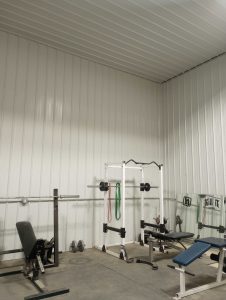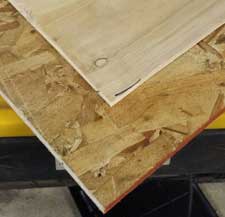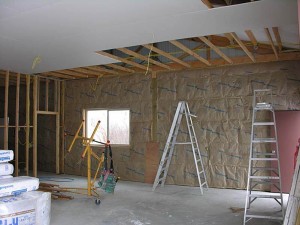In many parts of the country, a popular ceiling is to use steel liner panels. Generally the liner panels are the same rib configuration as steel roofing and siding, the difference being the panels themselves generally have little or no warranty on either the paint, or the steel themselves. As the paint is not exposed to the elements, this is really of no concern. These liner panels usually have a minimal coating of galvanization under the paint, so protection against rusting is low. Due to both of these factors, the cost of the material is lower than siding and roofing panels which require more protection from weather and sunlight deterioration.
In many cases, the steel liner panels are screwed directly to widely spaced trusses, sometimes spanning eight to 12 feet. This results in the liner panels having a noticeable sag between the trusses, especially if insulation is blown in on top of the panels.
 The common reasoning in using liner panels, as opposed to say… gypsum wallboard, is they are far lighter in weight, so the roof trusses do not need to carry as high of a load. Many people seem to feel the use of white painted liner panels, contributes to the building being brighter inside, when lights are turned on. Cost is also often mentioned as a factor, however properly installed liner panels, with framing close enough to minimize sagging, and drywalled systems are fairly close to the same price.
The common reasoning in using liner panels, as opposed to say… gypsum wallboard, is they are far lighter in weight, so the roof trusses do not need to carry as high of a load. Many people seem to feel the use of white painted liner panels, contributes to the building being brighter inside, when lights are turned on. Cost is also often mentioned as a factor, however properly installed liner panels, with framing close enough to minimize sagging, and drywalled systems are fairly close to the same price.
My own objection to steel liner panels is the noise factor. Drywall tends to absorb sound, where steel liner panels reflect it.
I also wondered if condensation on the underside of the panels could ever be a problem. Warm moist air inside the building rises, comes in contact with the ceiling liner panel steel (which will often be colder in fall, winter, spring than the inside the building) and condensation should occur. Having never owned a pole building with a steel liner, I couldn’t vouch for the actual situation personally.
Well, I got my answer today, from an online forum post:
“I think it depends on how tight your building is. My metal garage has two roll up doors and there is a gap at the top of them. In the winters, I had no problems with condensation on the metal ceiling until I sealed over the doors with OSB. I have insulation stuffed in all of the grooves on the inside at the edge of the metal roof. So, that made it pretty air tight. Now in the winters, when the roof has frost or snow on it, when the sun comes out, the metal ceiling will drip water on my car. I have to cover it with a plastic tarp to keep the water off of it.”
Personally, my idea of having things inside a building is to avoid having to break out the blue tarps! Considering a steel liner panel ceiling in a new pole building? I’d recommend thinking long and hard before you jump into this one.









This post about metal ceiling liners leaves a little too much in question. Firstly, if the metal ceiling liners are condensing water from the air, they must be colder than the surrounding air. This implies that there is not much insulation above them to isolate the cold exterior from the “warmer” interior, right? So this condensation might not be a problem if the ceiling was insulated properly, right? Second, if you were to have sheetrock in place of metal liners on the ceiling in this case, wouldn’t you have soggy sheetrock now, that would eventually mold/ rot/ drop onto the car? Personally I’d rather have water dripping than sheetrock dropping! Of course, I feel insulation would solve both these problems. Third, I feel like there has to be a TON of water in the air for enough condensation to collect and drip like that in wintertime (snow on the roof AND sun, still winter or early spring at least). Wouldn’t that be coming from an porous slab without a vapor barrier below? Either way, it sounds like a “perfect storm” combination of factors that cause this extreme condensation. I’d like to hear your thoughts on it, as I’m in the process of planning my own building! Thanks, your website is a wealth of information, for sure!
-Dave
Thank you for your kind words Dave, the goal is to be both informative and entertaining.
The concept of a dead attic space with insulation at ceiling level is to create a cool (in winter anyhow) unconditioned area. It could be possible to have enough attic insulation to prevent the steel liner from being cooler than the air in the conditioned space below, but I personally would not want to rely upon it.
Steel is an excellent conductor of heat and cold, gypsum wallboard is not. The facing of the sheetrock also acts as a vapor barrier and the core (the gypsum) provides a thermal break between the faces. Basically – two very dissimilar products.
And yes, it takes having moisture present. Usually the moisture is coming through a slab which does not have a vapor barrier. There are also times when the ambient humidity is such as to potentially cause the same challenges.
https://www.houzz.com/hznb/photos/morton-building-photos-phvw-vp~135890575
An awesome style statement, I have done some investigating of the perceived noise issues….not an issue it’s all in the application.
Condensation….poorly executed system, not just the metal, it is a system of components beginning with the under-slab vapor barrier
Hello,
I am thinking of installing metal liner panels on the interior walls of my shop It is a pole type building with 6×6’s spaced 8 foot On Center. What is the recommended horizontal lumber for the fasteners and what would be the typical “spacing between the horizontal pieces be they 1×4 or 2×4 untreated lumber.?
Most generally 2×4 #2 (not Std&btr) spaced 24 inches on center with wide face attached to inside face of columns.
need a price on 8000 sq ft 3 foot wide liner panel and r-19 x 4 foot wide roll ins. w/ barrieir on 1 side and tabs to attach to wood frame ag bldg.
Your inquiry has been forwarded to our Materials Department
I need a price quote on ceiling liner panels 3 ft. by 26 ft. for my garage. Its 26 ft. wide and 30 ft. deep with 9 ft. ceilings my trusses are spaced at 46″. I’m thinking 1/2 inch panels will be enough to support the 4 to 6 inch roll in insulation with out sagging. Will I need a barrier? The garage is all wood. Do you cut the lengths to exact measurements the width is actually 25′ 7″ and and depth is 29′ 6″ does that cost extra to have them cut. Thank you.
Your steel liner panels will have approximately 5/8″ high ribs. You will not need a barrier and the insulation batts should be unfaced (as well as at least R-30 if not thicker). You order the panels cut to the exact length to fit between your walls. Attic space above insulation will need to be adequately vented. For a price on panels please contact Materials@HansenPoleBuildings.com.
Pole barn is 40×60 with poles 8′ oc. the trusses are 4′ on center. walls are 14′ high. looking for a price on white liner panels and the edging detail to attach it. please include the screws with your price. Thanks
Thank you for your interest, please reach out to Materials@HansenPoleBuildings.com for a price quote, include your site address and best contact number.
Am wondering about hanging ceiling in new construction pole barn with trusses spaced 10′ apart. Is it best to just frame in between trusses at 2′ or 4′ intervals? Was wanting to hang steel ceiling, and am not sure how far it can span. It seems there is a lot of differing opinions on this. Also am wondering after ceiling is up, what is the procedure for blowing in insulation? Do you haul up a couple planks to walk on?
While I know there are people who hang steel ceilings to trusses spaced every 10′ without intermediate framing, it is not anything I would do or recommend. Personally, 2×6 joist hung every four feet should prove adequate. Check with whomever is going to blow in your insulation to see what they would like to have available to stand on while installing.
Will liner panels on 8ft oc trusses sag with blow in fiberglass insulation? for ceiling
There will be some minor deflection, however we see builders doing this on a regular basis. It would not be our recommendation.
Some companies like metal sales in the Midwest have what they call acoustic liner panel and it has a little holes punched through it like the old car speaker covers and it really cuts down the noise. I used it in a commercial gathering space where they held parties with lots of conversation and it’s best Hall acoustically speaking in town.